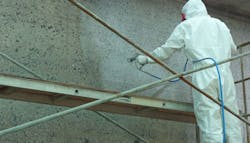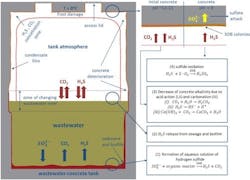The Most Common Tank Coatings & Application Mistakes
About the author:
Arianna Berry is a freelance writer for Water & Wastes Digest. Berry can be reached at [email protected] or 904.451.1565.
Water and wastewater each have unique struggles that people can address by applying protective coatings. This protection is especially important to wastewater disposal and treatment structures prone to environmental challenges, such as wetting-drying cycles, microbiologically-induced chemicals, cavitation, solid particle friction, carbonation and periods of freezing and thawing.
It can take days for wastewater to get to a plant, and during that time, microorganisms wreak havoc on substrates. For example, anaerobic sulfate-reducing bacteria (SRB) digest solid wastes, deposit polythionates and other sulfates onto the concrete and release carbonic acid (H2CO3) into the air above.
Virgin concrete’s alkaline chemistry then reacts with the carbonic acid to dramatically lower the concrete’s pH, which creates an optimal environment for “concrete devouring” bacteria in the head space above the wastewater. As a result, sulfur-oxidizing bacteria (SOB) Thiobacillus (among others) speed concrete corrosion by producing hydrogen sulfide (H2S) gas that combines with water to form strongly corrosive sulfuric acid (H2SO4). This microbiologically influenced corrosion (MIC) of concrete and metal surfaces causes billions of dollars worth of water and sewer system damage in the U.S. annually.
Protective coatings are often applied to concrete and metal components to mitigate this costly degradation. However, they only offer adequate substrate protection so long as they remain intact and must be applied flawlessly with no blisters, bugholes, honeycombs, pores, pinholes or punctures.
While coatings are typically epoxy-, polyurethane- or polyurea-based, some promising new hybrids are on the market.
The Most Common Coating Materials
Epoxy Coatings. Epoxies (typically high solids, amine-cured) are commonly used in damp environments such as wet wells, maintenance holes and clarifiers. These acid-resistant coatings are typically high build and offer long-lasting moisture and vapor corrosion protection by preventing water penetration. Epoxies can also be formulated to be used in water applications certified to ANSI 61 potable water.
As a rule of thumb, unless applying a cement-epoxy mortar, wait 28 days (as per SSPC’s SP 13) before applying an epoxy coating to new concrete. This waiting period allows the concrete to hydrate, to allow the moisture content to drop to less than 4%, and is vital to ensure the tenacious mechanical bond that epoxy coatings take about four to five hours to develop.
Polyurethane Coatings. Polyurethanes are typically high solids, high build, aromatic and two-component. They resist high acid concentrations and are unique in that they can be either flexible or rigid. They allow for fast return to service and require as little as 30 minutes for a solid cure. However, the higher moisture vapor transmission rate can translate to a weaker bond.
Spray-applied Polyurea Coatings. Like Polyurethanes, spray-applied polyureas are organic polymers, allow for a fast return to service, are flexible and allow for structural movement. However, they may allow for more moisture vapor transmission and are not as effective for full immersion for clarifier components. They cure so rapidly that they may not adequately wet the concrete to develop the needed adhesion for a strong bond. In addition, some formulations cannot withstand hydrolysis and dissolve in water.
In 2000, Tripp Ishmael of Raven Lining Systems (acquired by PPG in February 2021) developed AquataFlex, a novolac epoxy-polyurethane hybrid that combines the chemical resistance of epoxy and the buildability of polyurethane with the flexibility of polyurea. AquataFlex products provide high-performance protection across a wide range of temperatures and humidities, are 100% solids with zero VOCs and are ANSI 61 certified for potable water use. In addition, they are certifiably bio-based and deliver strong adhesion properties to properly prepared concrete, steel, aluminum, wood and composites.
Common Mistakes for Coatings Applications
Most mistakes can be avoided by adhering to the manufacturer product data-sheet or application guideline documents:
Improper Surface Preparation. This step is crucial, as coatings only work as designed when the substrate they are applied to has been adequately prepared. Otherwise, coatings are at risk of premature failure and subsequently exposing concrete to wastewater hazards. The best surface prep method is brush-off blast cleaning (also known as sweep blast). Thoroughly clean the surface afterward, as any laitance remaining can result in poor adherence and lead to chipping, peeling or flaking that would not ordinarily occur.
Applying a Coating to Outgassing Concrete. Outgassing can cause blisters, pinholes or pimples that lead to delamination. To combat outgassing, consider applying the coating at night or as the temperature cools — never as it warms — as sunlight and warmth can draw water vapor from concrete.
To ensure that outgassing is not occurring, perform a simple “Mat Test” (ASTM D 4263) by taping an 18-inch by 18-inch polyethylene sheet to the concrete surface and for a minimum of 16 hours. If any water droplets or condensation are noted under the sheet, outgassing is occurring, and you should not apply the coating yet.
Applying a Hydrophobic Coating Directly to Concrete With Moisture Content Over 4%. Excess moisture content can cause bugholes, honeycombs and pores that make it nearly impossible to apply the coating to the manufacturer’s specified thickness consistently.
To prevent these defects, level the surface of the concrete with a moisture vapor rate of up to 12% with a thin cement-epoxy mortar (commercial blends are available.) The mortar will temporarily block moisture on the concrete’s surface long enough for a hydrophobic coating to bond.
Applying a Protective Coating System That Does Not Correctly Meet Site Needs. A few things to consider when selecting the suitable coating include wetness exposure time, physical and chemical conditions, and the prepared substrate condition.
SSPC’s Painting Contractor Certification Program (PCCP) evaluates contractor capabilities to complete protective coating application work and train industry consultants and contractors to correctly specify and apply coatings for corrosion protection.
Using Unproven Products. One study of a wastewater treatment plant in Poland (Woyciechowski et al., 2021) found severe corrosion symptoms on the tanks after just two years of service due to the failure of the epoxy coating. Vapor permeability was found to be “probably much higher than declared by the manufacturer due to its highly porous structure and lower than recommended average thickness.” The product did not live up to the manufacturer’s claims, and it was an expensive mistake.
Use only products that have been thoroughly vetted such as those of Tnemec, Sherwin-Williams or PPG. Water/Wastewater Segment Manager Kathy Romans said that PPG’s Raven Lining Systems product portfolio has been in service for almost 35 years, with Raven 405 being one of the most specified and proven on the market.
“PPG products can be used for the entire lifeline of a project. All the way from the manhole to the treatment system,” she said. “Our halls-to-walls coatings can cover every structure in a facility.”
Using Unqualified Contractors to Apply High-Performance Protective Coatings. Only properly-trained applicators should apply protective coating systems. Look for SSPC-QP 8 approved contractors, as they have been explicitly evaluated as qualified to coat concrete.
According to consultant Gary Hall, when a preferred contractor or low-bidder fails to deliver a proper coating application, it typically comes down to a lack of required equipment, skill level or experience. Not having bid sufficiently to allow for the use of quality materials or not having a contractor discount available with the specified coating manufacturer may also be a sign for unqualified contractors. So be mindful of and avoid these potential pitfalls.
A Set-It-And-Forget-It Mentality. As of yet, there is no permanent solution to the deterioration caused by the corrosive environment of wastewater systems. Protective coatings mitigate damage but must be monitored and maintained. Inspect your coatings regularly and plan for recoatings per manufacturer recommendations.
Differences Between Drinking Water & Wastewater Coating Applications
Any protective coating that may contact potable water requires ANSI 61 standard testing data per the NSF. Some products are both gentle and tough, which testing demonstrates is suitable for both water and wastewater applications.
While some coating products are suitable for steel and concrete and water and wastewater use, the severe wastewater environment typically requires more acid resistance and a higher dry film thickness (DFT).
Resources are available to help guide utilities in determining which coatings may suit a project. Engineers, municipalities and inspectors can find easy-to-follow application guides on manufacturer websites, as well. A small selection of resources can be found in the sidebar on this page.
Protective coatings play an important role in prolonging the service life of water and wastewater disposal and treatment structures. Coatings continue performing admirably for several decades. To ensure the longest possible service life, avoid making common and costly coating application mistakes.
Coatings Resources
PPG Interactive Systems Guide:
Sherwin-Williams:
bit.ly/sherwinwilliamsresources
Tnemec University:
References
- Featured thought leader: Mar systems. Waterworld February 1, 2016. (n.d.). Retrieved January 14, 2022, from http://newsletters. pennnet.com/waterworldenl/367203141.html
- Hall, G. (n.d.). Coating issues in wastewater treatment collection and Treatment Systems.
- Coating Issues In Wastewater Treatment Collection And Treatment Systems. Retrieved January 14, 2022, from https://www. wateronline.com/doc/coating-issues-in- wastewater-treatment-collec-0001
- Illig, G. (2021, March 1). Protecting concrete tanks in water and wastewater treatment plants. Water & Wastes Digest. Retrieved January 14, 2022, from https://www.wwdmag. com/tank-industry-consultants/protecting- concrete-tanks-water-and-wastewater- treatment-plants
- Protective coatings commonly used in wastewater facilities. AMPP. (2019, June 12). Retrieved January 14, 2022, from https:// sspc.org/learning_center/protective-coatings- commonly-used-in-wastewater-facilities/
- Woyciechowski, P., Łukowski, P., Szmigiera, E., Adamczewski, G., Chilmon, K., & Spodzieja, S. (2021, August 19). Concrete Corrosion in a wastewater treatment plant – a comprehensive case study. Construction and Building Materials. Retrieved January 14, 2022, from https://www.sciencedirect.com/science/article/pii/ S0950061821021462

